Changes in Runoff and Sediment Load and Potential Causes in the Malian River Basin on the Loess Plateau
Abstract
:1. Introduction
2. Material and Methods
2.1. Study Area
2.2. Data Sources
2.3. Methodologies
2.3.1. Mann–Kendall Trend Test
2.3.2. Change Point Analysis
2.3.3. Runoff Depth and Specific Sediment Yield
2.3.4. Double-Mass Curve Method
2.3.5. Sediment Identity Factor Analysis
3. Results
3.1. Temporal Variation of Runoff And Sediment Load
3.2. Spatial Patterns in Runoff and Sediment Load
3.3. Contributions of Human Activities and Rainfall to Runoff and Sediment Load Reduction
4. Discussion
4.1. Impacts of Climate Change on Runoff and Sediment Load
4.2. Impacts of Human Activities on Runoff and Sediment Load
5. Conclusions
Author Contributions
Funding
Institutional Review Board Statement
Informed Consent Statement
Data Availability Statement
Conflicts of Interest
References
- Guo, M.M.; Wang, W.L.; Kang, H.L.; Yang, B. Changes in soil properties and erodibility of gully heads induced by vegetation restoration on the Loess Plateau, China. J. Arid Land 2018, 10, 712–725. [Google Scholar] [CrossRef] [Green Version]
- Shi, Q.H.; Wang, W.; Zhu, B.; Guo, M. Experimental study of hydraulic characteristics on headcut erosion and erosional response in the tableland and gully regions of China. Soil Sci. Soc. Am. J. 2020, 84, 700–716. [Google Scholar] [CrossRef] [Green Version]
- Li, Z.; Liu, W.-Z.; Zhang, X.-C.; Zheng, F.-L. Assessing the site-specific impacts of climate change on hydrology, soil erosion and crop yields in the Loess Plateau of China. Clim. Chang. 2010, 105, 223–242. [Google Scholar] [CrossRef]
- Li, Z.; Zhang, Y.; Zhu, Q.; He, Y.; Yao, W. Assessment of bank gully development and vegetation coverage on the Chinese Loess Plateau. Geomorphology 2015, 228, 462–469. [Google Scholar] [CrossRef]
- Zhao, M.W.; Tang, G.A.; Li, F.Y.; Yuan, B.Y.; Lu, Z.C. Significance of impact factors upon Erosion and sediment yield on Northern Shaanxi Loess Plateau Province based on BP neural network. Bull. Soil Water Conserv. 2012, 32, 5–9. [Google Scholar]
- Zhu, S.J.; Tang, G.A.; Li, F.X.; Xiong, L.Y. Spatial variation of hypsometric integral in the loess plateau based on DEM. Acta Geogr. Sin. 2013, 68, 921–932. [Google Scholar]
- Wu, Z.J.; Zhao, D.Y.; Che, A.L.; Chen, D.W.; Liang, C. Dynamic response characteristics and failure mode of slopes on the loess tableland using a shaking-table model test. Landslides 2020, 17, 1561–1575. [Google Scholar] [CrossRef]
- Zhang, X.P.; Zhang, L.; Zhao, J.; Rustomji, P.; Hairsine, P. Responses of streamflow to changes in climate and land use/cover in the Loess Plateau, China. Water Resour. Res. 2008, 44. [Google Scholar] [CrossRef]
- Zhang, B.J.; Zhang, G.H.; Yang, H.Y.; Wang, H. Soil resistance to flowing water erosion of seven typical plant communities on steep gully slopes on the Loess Plateau of China. Catena 2019, 173, 375–383. [Google Scholar] [CrossRef]
- Haddeland, I.; Heinke, J.; Biemans, H.; Eisner, S.; Florke, M.; Hanasaki, N.; Konzmann, M.; Ludwig, F.; Masaki, Y.; Schewe, J.; et al. Global water resources affected by human interventions and climate change. Proc. Natl. Acad. Sci. USA 2014, 111, 3251–3256. [Google Scholar] [CrossRef] [Green Version]
- Walling, D.E.; Fang, D. Recent trends in the suspended sediment loads of the world’s rivers. Glob. Planet. Chang. 2003, 39, 111–126. [Google Scholar] [CrossRef]
- Wang, H.J.; Saito, Y.; Zhang, Y.; Bi, N.S.; Sun, X.X.; Yang, Z.S. Recent changes of sediment flux to the western Pacific Ocean from major rivers in East and Southeast Asia. Earth-Sci. Rev. 2011, 108, 80–100. [Google Scholar] [CrossRef]
- Mikhailova, M.V. Transformation of the Ebro River Delta under the impact of intense human-induced reduction of sediment runoff. Water Resour. 2003, 30, 370–378. [Google Scholar] [CrossRef]
- Meade, R.H.; Moody, J.A. Causes for the decline of suspended-sediment discharge in the Mississippi River system, 1940–2007. Hydrol. Process. 2010, 24, 35–49. [Google Scholar] [CrossRef]
- Carriquiry, J.D.; Sánchez, A. Sedimentation in the Colorado river delta and upper gulf of California after nearly a century of discharge loss. Mar. Geol. 1999, 158, 125–145. [Google Scholar] [CrossRef]
- Naik, P.K.; Jay, D.A. Distinguishing human and climate influences on the Columbia River: Changes in mean flow and sediment transport. J. Hydrol. 2011, 404, 259–277. [Google Scholar] [CrossRef]
- Labat, D.; Godderis, Y.; Probst, J.L.; Guyot, J.L. Evidence for global runoff increase related to climate warming. Adv. Water Resour. 2004, 27, 631–642. [Google Scholar] [CrossRef]
- Walling, D.E. Human impact on land–ocean sediment transfer by the world’s rivers. Geomorphology 2006, 79, 192–216. [Google Scholar] [CrossRef]
- Wang, S.; Fu, B.J.; Piao, S.L.; Lv, Y.H.; Ciais, P.; Feng, X.M.; Wang, Y.F. Reduced sediment transport in the Yellow River due to anthropogenic changes. Nat. Geosci. 2015, 9, 38–41. [Google Scholar] [CrossRef]
- Chen, D.; Wei, W.; Chen, L.D. Effects of terracing practices on water erosion control in China: A meta analysis. Earth Sci. Rev. 2017, 173, 109–121. [Google Scholar] [CrossRef]
- Boix-Fayos, C.; de Vente, J.; Martinez-Mena, M.; Barbera, G.G.; Castillo, V. The impact of land use change and check-dams on catchment sediment yield. Hydrol. Process. 2008, 22, 4922–4935. [Google Scholar] [CrossRef]
- Abedini, M.; Said, M.A.M.; Ahmad, F. Effectiveness of check dam to control soil erosion in a tropical catchment (The Ulu Kinta Basin). Catena 2012, 97, 63–70. [Google Scholar] [CrossRef]
- Wang, F.; Zhao, G.J.; Mu, X.M.; Gao, P.; Sun, W.Y. Regime shift identification of runoff and sediment loads in the Yellow River Basin, China. Water 2014, 6, 3012–3032. [Google Scholar] [CrossRef] [Green Version]
- Wei, Y.H.; Jiao, J.Y.; Zhao, G.J.; Zhao, H.K.; He, Z.; Mu, X.M. Spatial-temporal variation and periodic change in streamflow and suspended sediment discharge along the mainstream of the Yellow River during 1950–2013. Catena 2016, 140, 105–115. [Google Scholar] [CrossRef] [Green Version]
- Mu, X.M.; Zhang, X.Q.; Shao, H.B.; Gao, P.; Wang, F.; Jiao, J.Y.; Zhu, J.L. Dynamic changes of sediment discharge and the influencing factors in the Yellow River, China, for the recent 90 years. CLEAN–Soil Air Water 2012, 40, 303–309. [Google Scholar] [CrossRef]
- Yao, W.Y.; Xiao, P.X.; Shen, Z.Z.; Wang, J.H.; Jiao, P. Analysis of the contribution of multiple factors to the recent decrease in discharge and sediment yield in the Yellow River Basin, China. J. Geogr. Sci. 2016, 26, 1289–1304. [Google Scholar] [CrossRef]
- Gao, G.Y.; Fu, B.J.; Zhang, J.J.; Ma, Y.; Sivapalan, M. Multiscale temporal variability of flow-sediment relationships during the 1950s-2014 in the Loess Plateau, China. J. Hydrol. 2018, 563, 609–619. [Google Scholar] [CrossRef]
- Zhang, Y.Z.; Zhang, D.Y.; Liu, Y.Y. Precipitation variation in Malianhe River Basin of the Loess Plateau in recent 50 years. Sci. Soil Water Conserv. 2016, 14, 44–52. [Google Scholar]
- Zhao, H.Y.; Zhang, X.D.; Wang, Y.H.; Zhang, Q.; Ma, P.L.; Yao, H.; Sun, L.D.; Qu, W.; Mao, Y.Q.; Yang, X.L. Climate change and their impact on water resources in the Loess Plateau of east Gansu. Agric. Res. Arid Areas 2011, 29, 262–268. [Google Scholar]
- Wang, Y.S.; Cheng, X.X.; Zhang, M.N.; Qi, X.F. Hydrochemical characteristics and formation mechanisms of Malian River in Yellow River basin during dry season. Environ. Chem. 2018, 37, 164–172. [Google Scholar]
- Mann, H.B. Non-parametric test against trend. Econometrica 1945, 13, 245–259. [Google Scholar] [CrossRef]
- Kendall, M.G. Rank Correlation Measures; Charles Grifn: London, UK, 1975; p. 202. [Google Scholar]
- Pettitt, A.N. A non-parametric approach to the change-point problem. J. R. Stat. Soc. 1979, 28, 126–135. [Google Scholar] [CrossRef]
- Assefa, K.; Moges, M.A. Low flow trends and frequency analysis in the Blue Nile Basin, Ethiopia. J. Water Resour. Prot. 2018, 10, 182–203. [Google Scholar] [CrossRef] [Green Version]
- Burn, D.H.; Elnur, M.A.H. Detection of hydrologic trends and variability. J. Hydrol. 2002, 255, 107–122. [Google Scholar] [CrossRef]
- Hirsch, R.M.; Slack, J.R.; Smith, R.A. Techniques of trend analysis for monthly water quality data. Water Resour. Res. 1982, 18, 107–121. [Google Scholar] [CrossRef] [Green Version]
- Guo, L.P.; Yu, Q.; Gao, P.; Nie, X.F.; Liao, K.T.; Chen, X.L.; Hu, J.M.; Mu, X.M. Trend and change-point analysis of streamflow and sediment discharge of the Gongshui River in China during the last 60 years. Water 2018, 10, 1273. [Google Scholar] [CrossRef] [Green Version]
- Siakeu, J.; Oguchi, T.; Aoki, T.; Esaki, Y.; Jarvie, H.P. Change in riverine suspended sediment concentration in central Japan in response to late 20th century human activities. Catena 2004, 55, 231–254. [Google Scholar] [CrossRef]
- Gao, P.; Li, P.F.; Zhao, B.L.; Xu, R.R.; Zhao, G.J.; Sun, W.Y.; Mu, X.M. Use of double mass curves in hydrologic benefit evaluations. Hydrol. Process. 2017, 31, 4639–4646. [Google Scholar] [CrossRef]
- Wang, S.; Fu, B.J.; Liang, W.; Liu, Y.; Wang, Y.F. Driving forces of changes in the water and sediment relationship in the Yellow River. Sci. Total Environ. 2017, 576, 453–461. [Google Scholar] [CrossRef]
- Zhao, G.J.; Mu, X.M.; Jiao, J.Y.; Gao, P.; Sun, W.Y.; Li, E.H.; Wei, Y.H.; Huang, J.C. Assessing response of sediment load variation to climate change and human activities with six different approaches. Sci. Total Environ. 2018, 639, 773–784. [Google Scholar] [CrossRef]
- Shi, H.Y.; Wang, G.Q. Impacts of climate change and hydraulic structures on runoff and sediment discharge in the middle Yellow River. Hydrol. Process. 2015, 29, 3236–3246. [Google Scholar] [CrossRef] [Green Version]
- Li, B.Q.; Liang, Z.M.; Zhang, J.Y.; Wang, G.Q.; Zhao, W.M.; Zhang, H.Y.; Wang, J.; Hu, Y.M. Attribution analysis of runoff decline in a semiarid region of the Loess Plateau, China. Theor. Appl. Climatol. 2016, 131, 845–855. [Google Scholar] [CrossRef]
- Nunes, J.P.; Seixas, J.; Keizer, J.J. Modeling the response of within-storm runoff and erosion dynamics to climate change in two Mediterranean watersheds: A multi-model, multi-scale approach to scenario design and analysis. Catena 2013, 102, 27–39. [Google Scholar] [CrossRef]
- Huang, Y.; Cai, J.L.; Yin, H.; Cai, M.T. Correlation of precipitation to temperature variation in the Huanghe River (Yellow River) basin during 1957–2006. J. Hydrol. 2009, 372, 1–8. [Google Scholar] [CrossRef]
- Xu, X.L.; Scanlon, B.R.; Schilling, K.; Sun, A. Relative importance of climate and land surface changes on hydrologic changes in the US Midwest since the 1930s implications for biofuel production. J. Hydrol. 2013, 497, 110–120. [Google Scholar] [CrossRef]
- Zhao, G.J.; Tian, P.; Mu, X.M.; Jiao, J.Y.; Wang, F.; Gao, P. Quantifying the impact of climate variability and human activities on streamflow in the middle reaches of the Yellow River basin, China. J. Hydrol. 2014, 519, 387–398. [Google Scholar] [CrossRef]
- Gao, G.Y.; Ma, Y.; Fu, B.J. Multi-temporal scale changes of streamflow and sediment load in a loess hilly watershed of China. Hydrol. Process. 2016, 30, 365–382. [Google Scholar] [CrossRef] [Green Version]
- Gao, P.; Geissen, V.; Ritsema, C.J.; Mu, X.M.; Wang, F. Impact of climate change and anthropogenic activities on stream flow and sediment discharge in the Wei River basin, China. Hydrol. Earth Syst. Sci. 2013, 17, 961–972. [Google Scholar] [CrossRef] [Green Version]
- Miao, C.Y.; Shi, W.; Chen, X.H.; Yang, L. Spatio-temporal variability of streamflow in the Yellow River: Possible causes and implications. Hydrol. Sci. J. 2012, 57, 1355–1367. [Google Scholar] [CrossRef] [Green Version]
- Wang, H.; Yang, Z.; Saito, Y.; Liu, J.P.; Sun, X.; Wang, Y. Stepwise decreases of the Huanghe (Yellow River) sediment load (1950–2005): Impacts of climate change and human activities. Glob. Planet. Chang. 2007, 57, 331–354. [Google Scholar] [CrossRef]
- Wang, Y.; Ding, Y.J.; Ye, B.S. Contributions of climate and human activities to changes in runoff of the Yellow and Yangtze rivers from 1950 to 2008. Earth Sci. 2013, 56, 1398–1412. [Google Scholar] [CrossRef]
- Yue, X.L.; Mu, X.M.; Zhao, G.J.; Shao, H.B.; Gao, P. Dynamic changes of sediment load in the middle reaches of the Yellow River basin, China and implications for eco-restoration. Ecol. Eng. 2014, 73, 64–72. [Google Scholar] [CrossRef]
- Chen, L.D.; Wei, W.; Fu, B.J.; Lv, Y.H. Soil and water conservation on the Loess Plateau in China: Review and perspective. Prog. Phys. Geogr. 2007, 31, 389–403. [Google Scholar] [CrossRef]
- Hessela, R.; Messing, I.; Chen, L.D.; Ritsemad, C.; Stolte, J. Soil erosion simulations of land use scenarios for a small Loess Plateau catchment. Catena 2003, 54, 289–302. [Google Scholar] [CrossRef]
- Jiao, J.J.; Joseph, T.; Xofis, P.; Bai, W.J.; Ma, X.H.; Mitchley, J. Can the study of natural vegetation succession assist in the control of soil erosion on abandoned croplands on the Loess Plateau, China? Restor. Ecol. 2007, 15, 391–399. [Google Scholar] [CrossRef]
- Li, B.Q.; Liang, Z.M.; Bao, Z.X.; Wang, J.; Hu, Y.M. Changes in streamflow and sediment for a planned large reservoir in the middle Yellow River. Land Degrad. Dev. 2019, 30, 878–893. [Google Scholar] [CrossRef] [Green Version]
- Miao, C.; Ni, J.; Borthwick, A.G.L.; Yang, L. A preliminary estimate of human and natural contributions to the changes in water discharge and sediment load in the Yellow River. Glob. Planet. Chang. 2011, 76, 196–205. [Google Scholar] [CrossRef] [Green Version]
- Mu, X.M.; Zhang, L.; McVicar, T.R.; Chille, B.; Gao, P. Analysis of the impact ofconservation measures on stream flow regime in catchments of the loess plateau, China. Hydrol. Process. 2007, 21, 2124–2134. [Google Scholar] [CrossRef]
- Xin, Z.B.; Yu, B.F.; Han, Y.G. Spatiotemporal variations in annual sediment yield from the middle Yellow River, China, 1950–2010. J. Hydrol. Eng. 2015. [Google Scholar] [CrossRef]
- Sharda, V.N.; Juyal, G.P.; Singh, P.N. Hydrologic and sedimentologic behavior of a conservation Bench Terrace System in a sub-humid climate. Trans. ASAE 2002, 45, 1433–1444. [Google Scholar] [CrossRef]
- Ma, Y.X.; Huang, H.Q.; Nanson, G.C.; Li, Y.; Yao, W.Y. Channel adjustments in response to the operation of large dams: The upper reach of the lower Yellow River. Geomorphology 2012, 147, 5–48. [Google Scholar] [CrossRef] [Green Version]
- Mekonnen, M.; Keesstra, S.D.; Stroosnijder, L.; Baartman, J.E.M.; Maroulis, J. Soil conservation through sediment trapping: A review. Land Degrad. Dev. 2015, 26, 544–556. [Google Scholar] [CrossRef]
- Jin, Z.; Cui, B.L.; Song, Y.; Shi, W.Y.; Wang, K.B.; Wang, Y.; Liang, J. How many check dams do we need to build on the Loess Plateau? Environ. Sci. Technol. 2012, 46, 8527–8528. [Google Scholar] [CrossRef]
- Ayalew, T.B.; Krajewski, W.F.; Mantilla, R. Exploring the effect of reservoir storage on peak discharge frequency. J. Hydrol. Eng. 2013, 18, 1697–1708. [Google Scholar] [CrossRef]
- Vörösmarty, C.J.; Meybeck, M.; Fekete, B.; Sharma, K.; Green, P.; Syvitski, J.P.M. Anthropogenic sediment retention: Major global impact from registered river impoundments. Glob. Planet. Chang. 2003, 39, 169–190. [Google Scholar] [CrossRef]
- Cao, S.X.; Chen, L.; Yu, X.X. Impact of China’s grain for green project on the landscape of vulnerable arid and semi-arid agricultural regions: A case study in northern Shanxi Province. J. Appl. Ecol. 2009, 46, 536–543. [Google Scholar] [CrossRef]
- McVicar, T.R.; Li, L.T.; Van Niel, T.G.; Zhang, L.; Li, R.; Yang, Q.Y.; Zhang, X.P.; Mu, X.M.; Wen, Z.M.; Liu, W.Z.; et al. Developing a decision support tool for China’s re-vegetation program: Simulating regional impacts of afforestation on average annual streamflow in the Loess Plateau. For. Ecol. Manag. 2007, 251, 65–81. [Google Scholar] [CrossRef]
- Xin, Z.B.; Ran, L.S.; Lu, X.X. Soil erosion control and sediment load reduction in the Loess Plateau: Policy perspectives. Int. J. Water Resour. Dev. 2012, 28, 325–341. [Google Scholar] [CrossRef]
- Yang, X.N.; Sun, W.Y.; Li, P.F.; Mu, X.M.; Gao, P.; Zhao, G.J. Reduced sediment transport in the Chinese Loess Plateau due to climate change and human activities. Sci. Total Environ. 2018, 642, 591–600. [Google Scholar] [CrossRef]
- Zuo, D.P.; Xu, Z.X.; Yao, W.Y.; Jin, S.Y.; Xiao, P.Q.; Ran, D.C. Assessing the effects of changes in land use and climate on runoff and sediment yields from a watershed in the Loess Plateau of China. Sci. Total Environ. 2016, 544, 238–250. [Google Scholar] [CrossRef]
- Zhang, J.X.; Zhang, B.; Ma, Z.H.; Yin, H.X.; Sun, L.W. A multitemporal study in Malian River Watershed of Loess Plateau. Remote Sens. Technol. Appl. 2013, 28, 137–143. [Google Scholar]

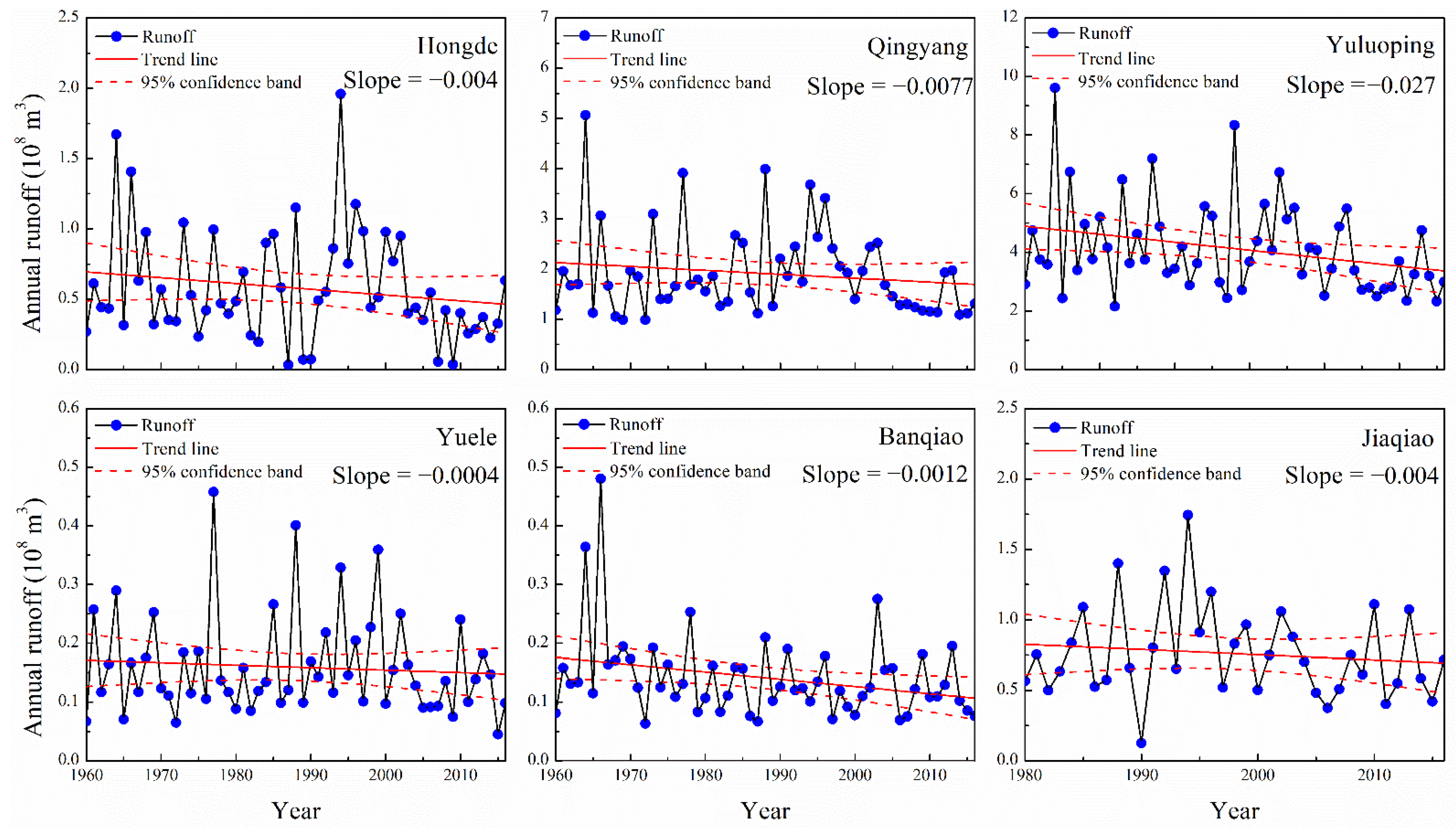
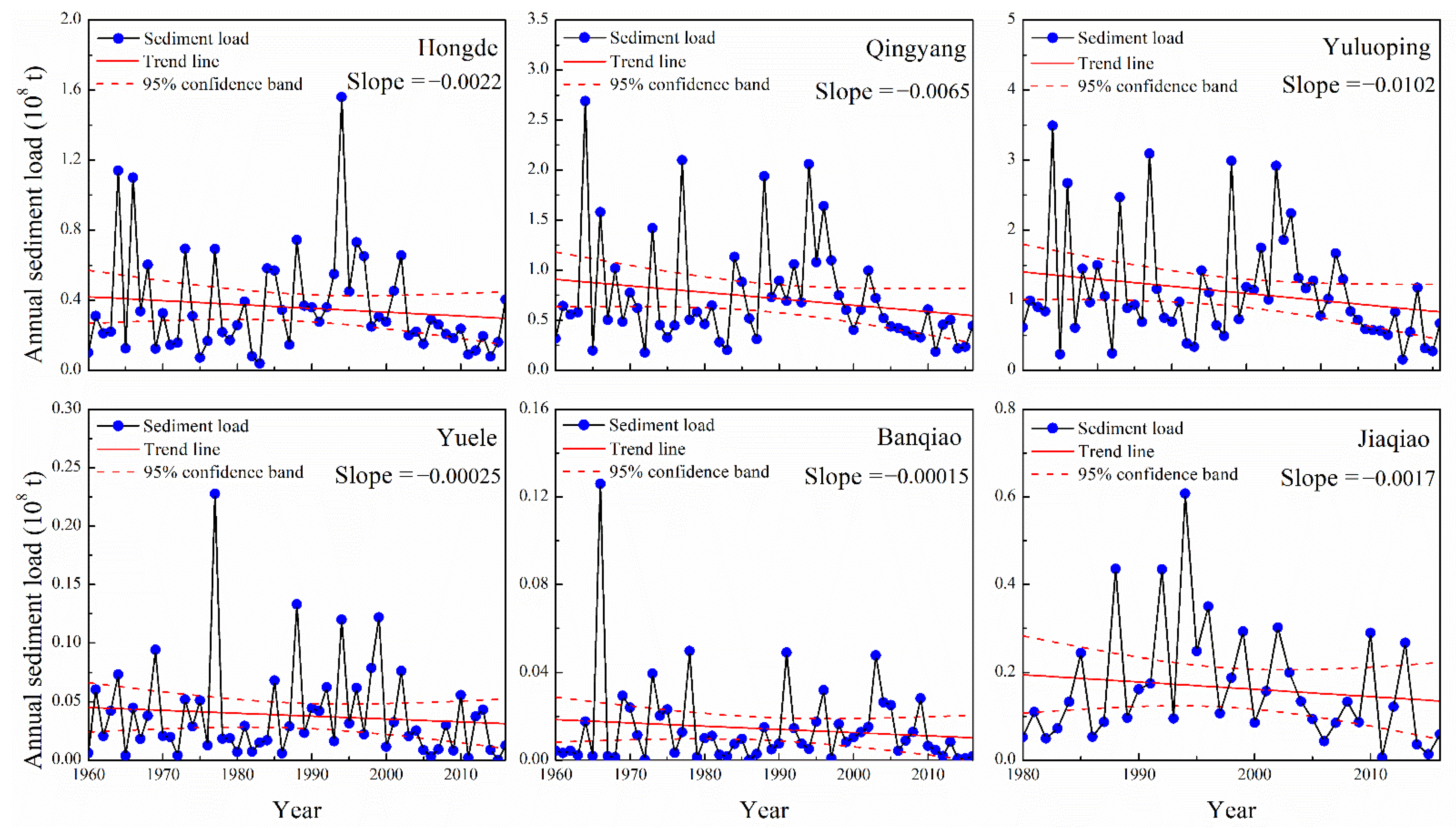


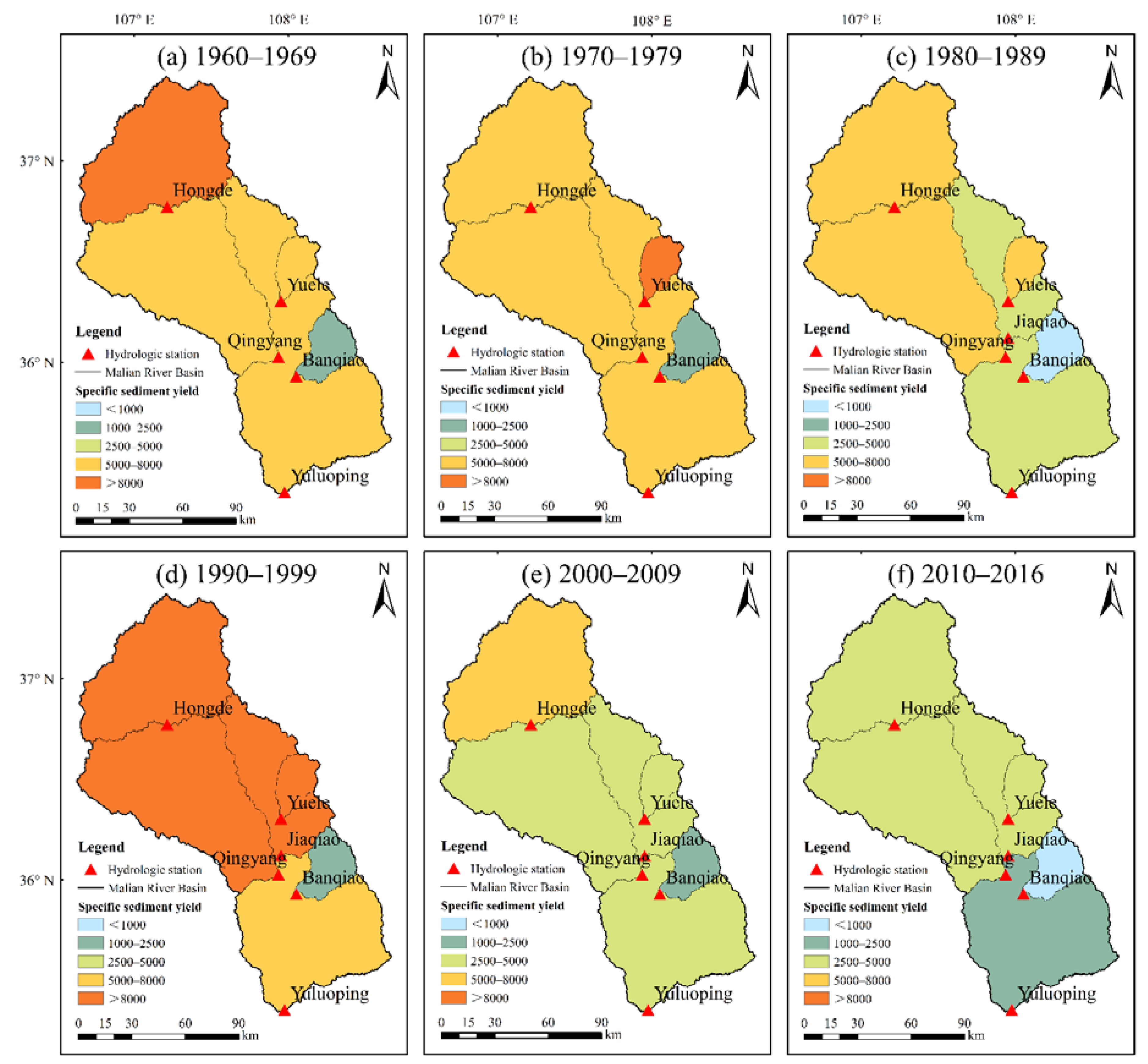
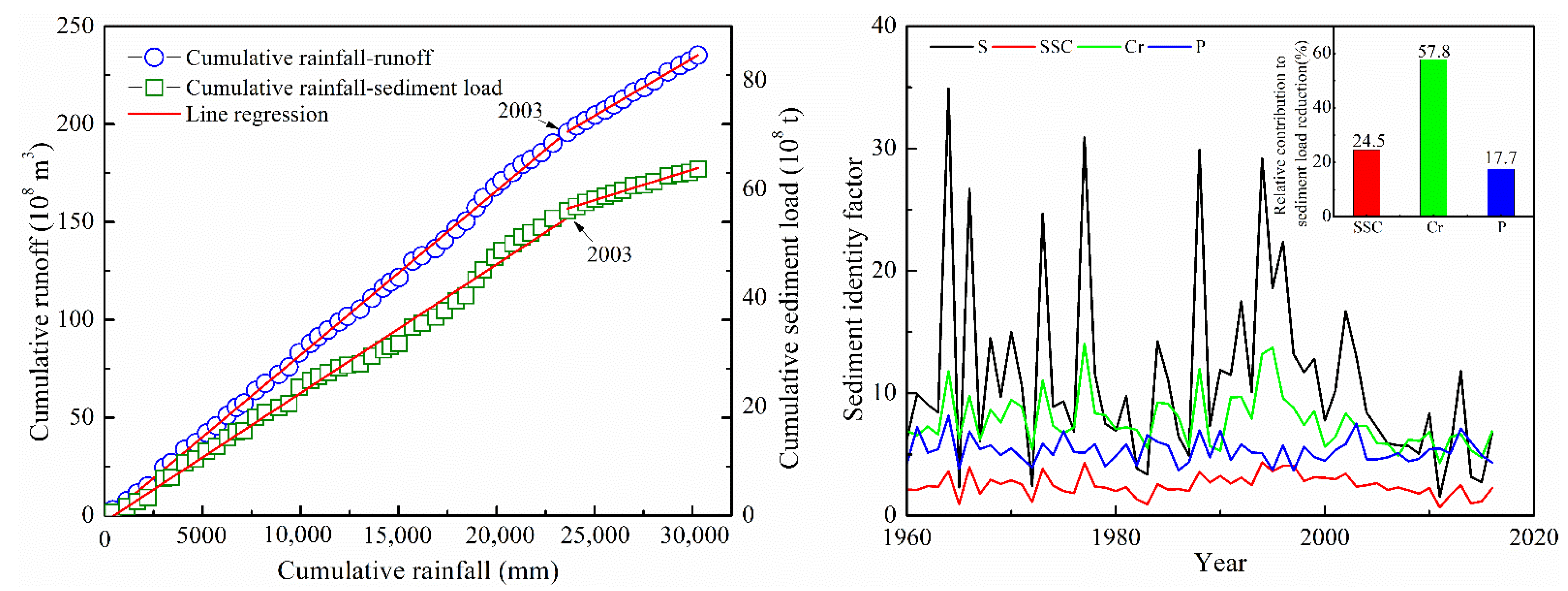
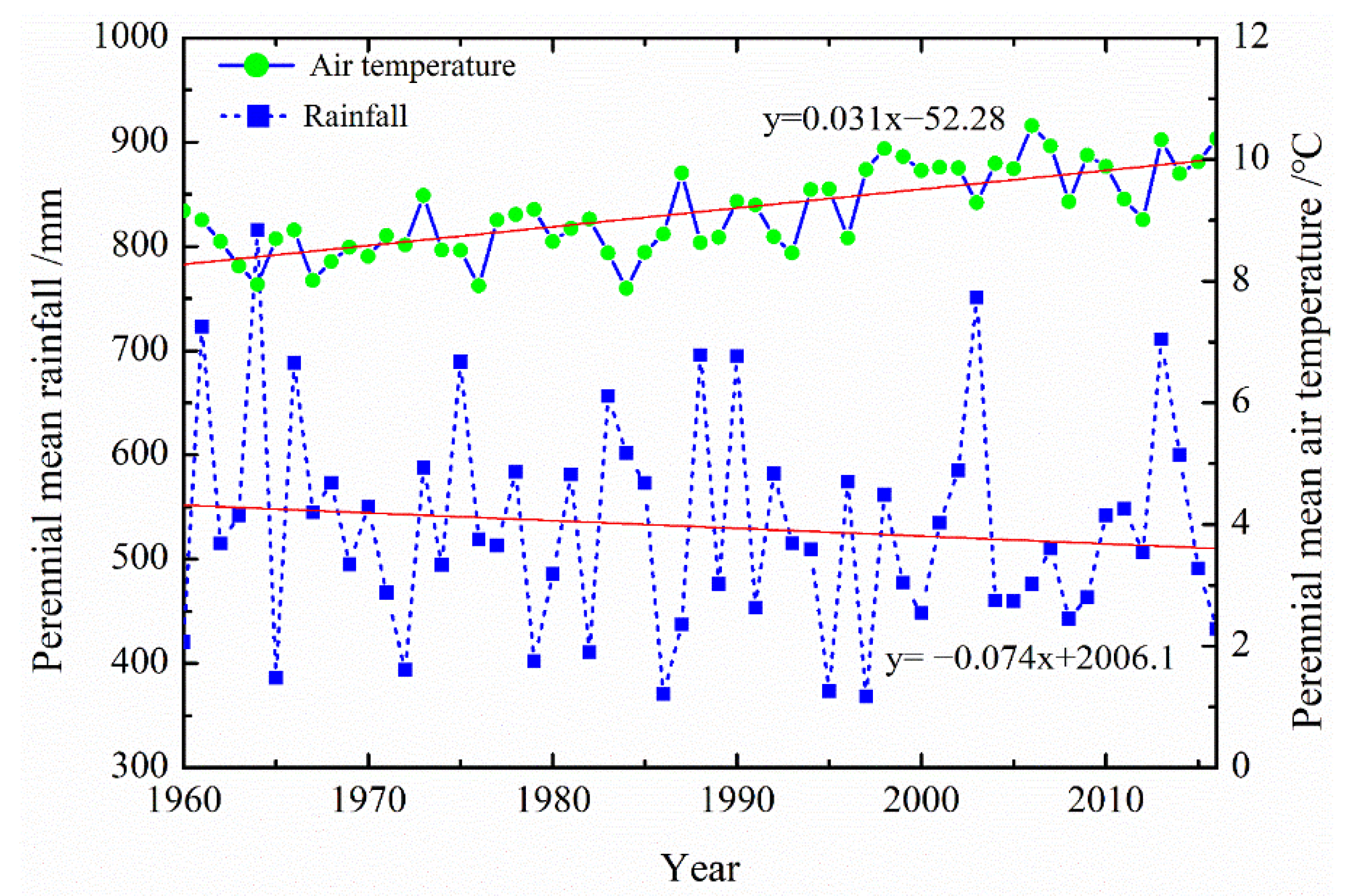
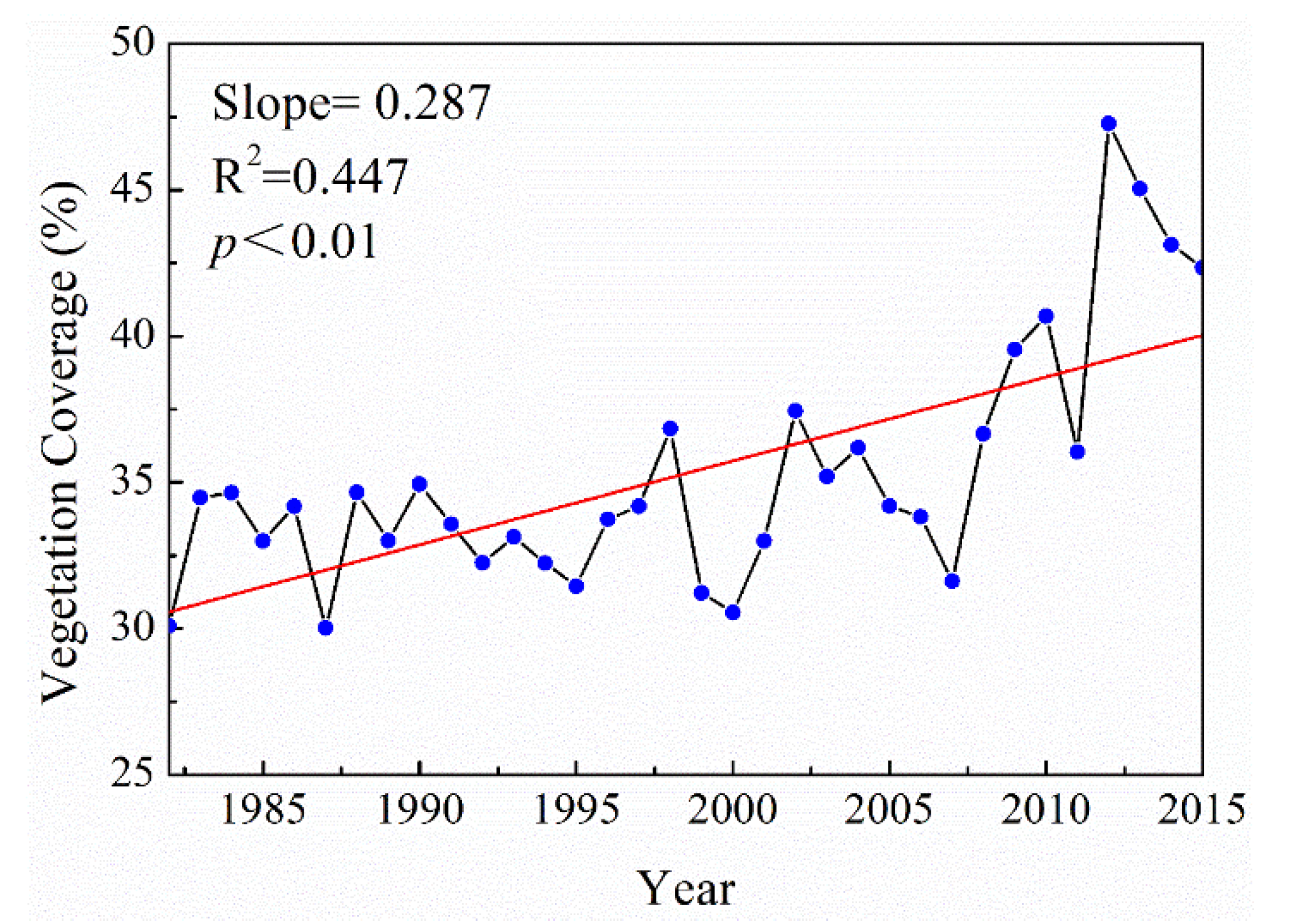
| River Name | Hydrological Station | Control Area (km2) | Data Series | Annual Runoff | Annual Sediment Load | |||
|---|---|---|---|---|---|---|---|---|
| Average (108 m3) | Standard Deviation | Average (108 t) | Standard Deviation | |||||
| 1 | Malian stream | Hongde | 4640 | 1960–2016 | 0.579 | 0.395 | 0.359 | 0.289 |
| 2 | Malian stream | Qingyang | 10,603 | 1960–2016 | 1.912 | 0.852 | 0.728 | 0.528 |
| 3 | Malian stream | Yuluoping | 19,019 | 1960–2016 | 4.127 | 1.546 | 1.119 | 0.765 |
| 4 | Rouyuanchuan | Yuele | 528 | 1960–2016 | 0.160 | 0.085 | 0.038 | 0.040 |
| 5 | Heshuichuan | Banqiao | 807 | 1960–2016 | 0.141 | 0.072 | 0.014 | 0.020 |
| 6 | Dongchuan | Jiaqiao | 2988 | 1980–2016 | 0.760 | 0.325 | 0.165 | 0.136 |
| Hydrologic Station | Runoff (108 m3) | Sediment Load (108 t) | ||
|---|---|---|---|---|
| M–K Test | Linear Trend | M–K Test | Linear Trend | |
| Hongde | −1.449 ns | 0.198 ns | −0.912 ns | 0.352 ns |
| Qingyang | −1.154 ns | 0.260 ns | −1.798 ns | 0.131 ns |
| Yuluoping | −2.442 * | 0.027 * | −1.918 ns | 0.099 ns |
| Yuele | −0.872 ns | 0.548 ns | −1.248 ns | 0.449 ns |
| Banqiao | −2.099 * | 0.031 * | −0.040 ns | 0.354 ns |
| Jiaqiao | −0.779 ns | 0.470 ns | −1.207 ns | 0.426 ns |
| Year | Runoff (108 m3) | Runoff reduction (108 m3) | Rainfall | Human activities | ||||
| Measured | Calculated | Value | Percentage | Value | Percentage | Value | Percentage | |
| 1960–2002 | 4.42 | |||||||
| 2003–2016 | 3.21 | 4.3 | 1.21 | 27.30% | 0.12 | 9.30% | 1.09 | 90.70% |
| Year | Sediment load (108 t) | Sediment load reduction (108 t) | Rainfall | Human activities | ||||
| Measured | Calculated | Value | Percentage | Value | Percentage | Value | Percentage | |
| 1960–2002 | 1.27 | |||||||
| 2003–2016 | 0.65 | 1.14 | 0.62 | 49.10% | 0.13 | 21.30% | 0.49 | 78.70% |
| References | Basin | Periods | Change Point | Methodology | Contribution to Runoff (%) | |
| Climate | Human Activities | |||||
| [52] | Yellow River basin | 1950–2008 | 1969 | Runoff coefficient | 17 | 83 |
| [43] | Wudinghe basin | 1961–2013 | 1970 | Double-mass curve | --- | 85.2–90.3 * |
| [49] | Wei River | 1932–2008 | 1968 | Double-mass curve | 17.8 | 82.8 |
| [50] | Yellow River basin | 2000–2008 | --- | Runoff coefficient | 45 | 55 |
| [48] | Yanhe River | 1952–2011 | 1979 | Double-mass curve | 34.29 | 65.71 |
| Basin | Periods | Change Point | Methodology | Contribution to Sediment Load (%) | ||
| Climate | Human Activities | |||||
| [51] | Yellow River basin | 1950–2005 | 1968 | Linear regression | 30 | 70 |
| [53] | Middle reaches of the Yellow River | 1962–2009 | 1979 | Linear regression | 44.6 | 55.4 |
| [49] | Wei River basin | 1932–2008 | 1981 | Double-mass curve | 4.44 | 95.56 |
| [50] | Yellow River basin | 2000–2008 | --- | Sediment-load coefficient | 56 | 54 |
| [48] | Yanhe River | 1952–2011 | 1979 | Double-mass curve | 34.29 | 65.71 |
Publisher’s Note: MDPI stays neutral with regard to jurisdictional claims in published maps and institutional affiliations. |
© 2021 by the authors. Licensee MDPI, Basel, Switzerland. This article is an open access article distributed under the terms and conditions of the Creative Commons Attribution (CC BY) license (http://creativecommons.org/licenses/by/4.0/).
Share and Cite
Du, M.; Mu, X.; Zhao, G.; Gao, P.; Sun, W. Changes in Runoff and Sediment Load and Potential Causes in the Malian River Basin on the Loess Plateau. Sustainability 2021, 13, 443. https://doi.org/10.3390/su13020443
Du M, Mu X, Zhao G, Gao P, Sun W. Changes in Runoff and Sediment Load and Potential Causes in the Malian River Basin on the Loess Plateau. Sustainability. 2021; 13(2):443. https://doi.org/10.3390/su13020443
Chicago/Turabian StyleDu, Min, Xingmin Mu, Guangju Zhao, Peng Gao, and Wenyi Sun. 2021. "Changes in Runoff and Sediment Load and Potential Causes in the Malian River Basin on the Loess Plateau" Sustainability 13, no. 2: 443. https://doi.org/10.3390/su13020443






